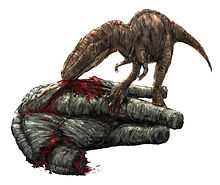Tyrannotitan
| Tyrannotitan Temporal range: Early Cretaceous, 118Ma | |
|---|---|
 | |
| Mounted skeleton | |
| Scientific classification | |
| Kingdom: | Animalia |
| Phylum: | Chordata |
| Clade: | Dinosauria |
| Suborder: | Theropoda |
| Clade: | †Carnosauria |
| Family: | †Carcharodontosauridae |
| Tribe: | †Giganotosaurini |
| Genus: | †Tyrannotitan Novas et al., 2005 |
| Species | |
| |
Tyrannotitan is a genus of huge bipedal carnivorous dinosaur of the carcharodontosaurid family from the Aptian stage of the early Cretaceous period, discovered in Argentina. It is closely related to other giant predators like Carcharodontosaurus and especially Giganotosaurus as well as Mapusaurus. Its fearsome appearance is reflected in the meaning of its name, "Tyrant titan".
Description


Little information has yet been offered about Tyrannotitan. Only a very brief description of the fossils has been published (four pages). The teeth are less blade-like than those of its kin, and possess odd, lumpy denticles (there is a barely distinguishable groove in the center, dividing each denticle into two parts). Unlike known carcharodontosaurids, this animal lacks pneumaticity extending into the sacral and caudal centra. The scapulocoracoid is fused, and much better developed than that of Giganotosaurus carolinii, yet the arm is very small. Most of the shaft of the scapula is missing.
The acromion curves about 90 degrees from the shaft axis, making it look vaguely tyrannosaurid-like. Whether the sharp difference between taxa is due to evolution or sexual dimorphism in poorly sampled populations of both species, has not been determined (the latter seems unlikely). A proximal caudal has a very tall neural spine (about twice the height of its centrum, judging by the figure). The base of the orbital fenestra is a notch of nearly 90 degrees into the body of the jugal, which contrasts with the rounded base restored for Giganotosaurus and agrees with Carcharodontosaurus favorably.
Discovery and species

Tyrannotitan chubutensis was described by Fernando E. Novas, Silvina de Valais, Pat Vickers-Rich, and Tom Rich in 2005.[1] The fossils were found at La Juanita Farm, 28 kilometres (17 mi) northeast of Paso de Indios, Chubut Province, Argentina. They are believed to have been from the Cerro Castaño Member, Cerro Barcino Formation (Aptian stage) around 112.2 - 121 million years ago.
The holotype material was designated MPEF-PV 1156 and included partial dentaries, teeth, back vertebrae 3-8 and 11-14, proximal tail vertebrae, ribs and chevrons, a fragmentary scapulocoracoid, humerus, ulna, partial ilium, a nearly complete femur, fibula, and left metatarsal 2.
Additional material (designated MPEF-PV 1157) included jugals, a right dentary, teeth, atlas vertebra, neck vertebra (?) 9, back vertebrae (?)7, 10, 13, fused sacral centra (5 total), an assortment of distal caudals, ribs, the right femur, a fragmentary left metatarsal 2, pedal phalanges 2-1, 2-2, and 3-3.
The length of these animals has been estimated at up to 12.2–13 metres (40–43 ft).[2][3]
The following cladogram after Novas et al., 2013, shows the position of Tyrannotitan within Carcharodontosauridae.[4]
| |
| ||||||||||||||||||||||||||||||||||||||||||||||||
| |
References
- ↑ Novas, F. E.; S. de Valais; P. Vickers-Rich; T. Rich (2005). "A large Cretaceous theropod from Patagonia, Argentina, and the evolution of carcharodontosaurids". Naturwissenschaften 92 (5): 226–230. doi:10.1007/s00114-005-0623-3. PMID 15834691.
- ↑ Rey LV, Holtz, Jr TR (2007). Dinosaurs: the most complete, up-to-date encyclopedia for dinosaur lovers of all ages (PDF). United States of America: Random House. ISBN 0-375-82419-7.
- ↑ Gregory S. Paul (2010). The Princeton Field Guide to Dinosaurs. United States of America: Princeton University Press. ISBN 9780691137209.
- ↑ Novas, Fernando E. (2013). "Evolution of the carnivorous dinosaurs during the Cretaceous: The evidence from Patagonia". Cretaceous Research 45: 174–215. doi:10.1016/j.cretres.2013.04.001.